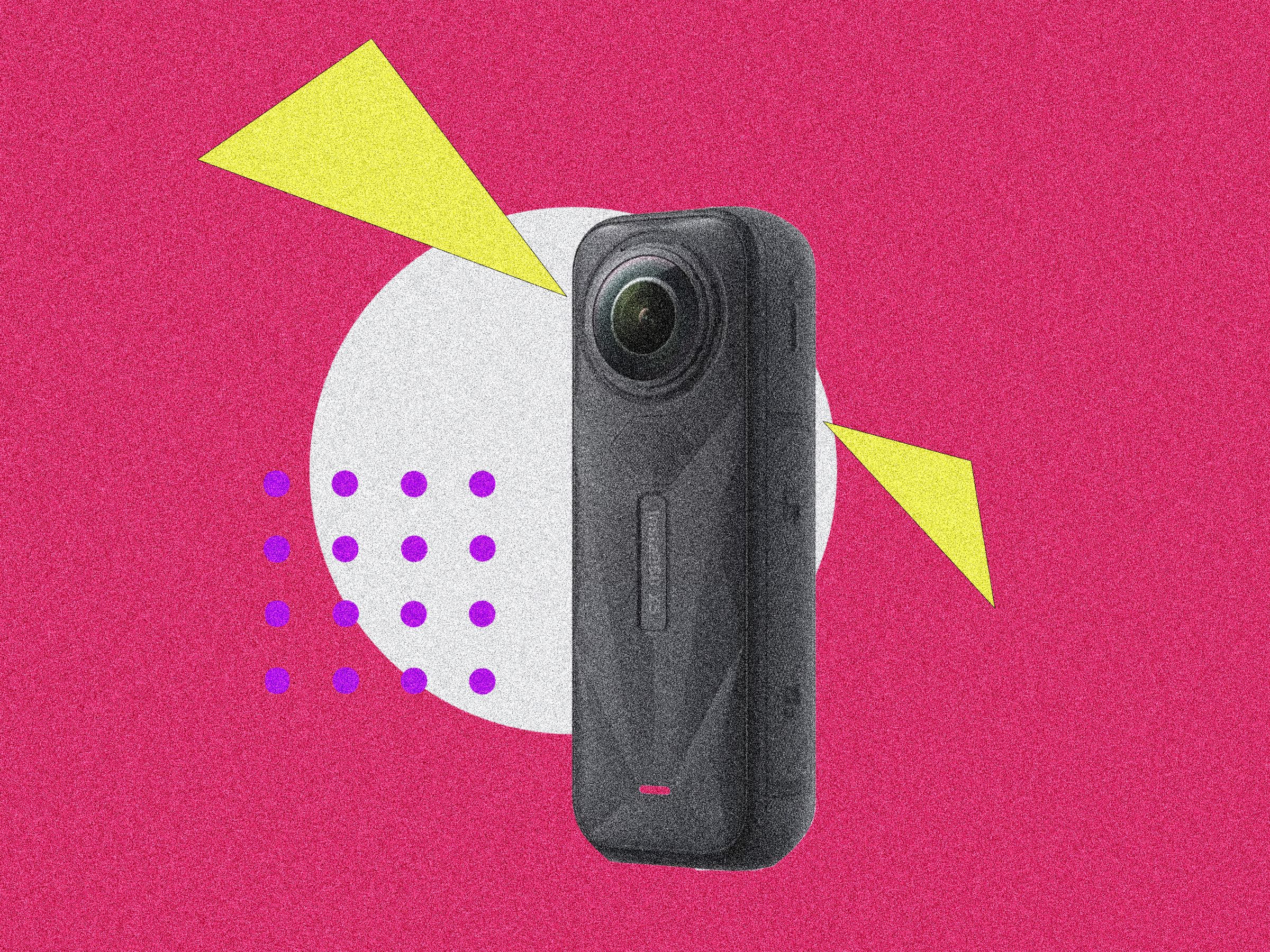Insta360’s X-series 360-degree cameras have long dominated the market. They have great video quality, an easy-to-use interface, and simple editing software, which makes these the most beginner-friendly 360 cameras around. The latest version, the Insta360 X5, continues that tradition while bringing larger sensors with even better-looking video.
The X5 is a worthy upgrade; video quality is better, battery life is improved, and new features like the PureVideo lowlight mode and replaceable lenses make the X5 the most compelling 360 camera on the market.
What’s New
Photograph: Scott Gilbertson
The big news in the X5, and the reason to consider upgrading even if you already have the X4, are the new twin 1/1.28-inch sensors. They’re a considerable step up from the 1/2-inch sensors in the X4. At the same time, the video specs have not changed much at all, with 8K 30 fps and 5.7K 60 fps at the high end. A larger sensor with the same resolution means more detail in that footage, which is exactly what you get here. This is without a doubt the best-looking footage I’ve seen from a 360 camera.
Keep in mind that the 8K refers to the overall 360-degree shot. When you actually frame that footage in the app, the highest resolution you’ll be able to export is 4K. But the 4K footage you’ll get is markedly better than what the X4 delivers.
The footage coming out of the X5 is great for a 360 camera. Bear in mind, though, that almost any other newer action camera is going to have somewhat better video quality. The appeal of the 360 camera is that it can capture what’s behind you, whereas Insta360’s traditional action cam, the Ace Pro 2 (8/10, WIRED Recommends), cannot. This makes 360 cameras perfect for filming when you don’t know exactly how you want to frame your shot, for example while riding a bike, skiing, skateboarding, and so on. In the past, to get this kind of shoot-everything, frame-later flexibility, you had to give up some video quality. While that’s still true to an extent, with the X5 you’re giving up very little in terms of video quality.
Photograph: Scott Gilbertson
This is especially noticeable in highlight retention, a place even action cams often struggle. On a bright day with a few clouds, a situation where you often end up with hazy, undersaturated skies, the X5 retains nice contrast and doesn’t wash out the highlights. The X5 delivers a much bluer, richer sky tone and more details in the clouds. There’s also a bit less noise in shadows when shooting at midday. What’s impressed me is that it’s capable of this in the default modes, without tweaking exposure or color.
The X5 has excellent dynamic range and mostly manages to avoid that overprocessed HDR look. There is an HDR mode, if you enjoy such things, but the resulting files are only 8-bit color depth (not 10-bit) and in the BT 709 color space, not DCI-P3 (or Apple’s Display P3). So while Insta360 calls this HDR, and it does seem to have a slightly wider dynamic range (along with more saturated colors), it’s not in the P3 color space.
Another improvement to video quality in the X5 is Insta360’s PureVideo low-light mode, which works just like it does in the Ace Pro 2. As with my earlier experiences, PureVideo is pretty amazing. Here it’s limited to 5.7K footage, but it manages to not just cut the noise in the shadows but does a reasonable job of protecting highlights too, which is important since bright lights are common in low-light scenarios.
Photograph: Scott Gilbertson
That said, I have seen some videos on YouTube showing a few edge cases where PureVideo fails, especially under blue light and very fast strobes (for example shooting a concert). In those cases you’ll have to turn off PureVideo and go with 8K footage and manual exposure. For most people, though, this won’t be an issue, and PureVideo makes the X5 considerably more capable than the X4.
There’s a new video mode as well, InstaFrame, which automatically tracks you through the shot. I’ll confess I don’t understand this mode. The whole point of a 360 camera is to get a 360 shot, which this does not. InstaFrame is also limited to lower-resolution modes like 5.7K+ or 5.7K, where the reframed output becomes 1080P. Why would I want this when I can do the very same thing in the Insta360 app and have 4K output?
I was excited to see that Insta360 has added support for I-LOG video recording. Unfortunately, that support is limited to 5.7K video. If you want to do your own color post-processing, you’re better off shooting in the usual flat mode at 8K and using that as a starting point. The small gain of I-LOG is negated by losing the 8K capture.
Body Image
Photograph: Scott Gilbertson
Insta360 X5 is close enough to the X4 in physical design that I didn’t notice much difference. There’s a 3D geometric pattern on the front of the X5, but otherwise the body looks about the same. For the hair-splitting among you, the X5 is a millimeter taller and narrower, and weighs 3 grams less the X4. Unfortunately, due to the repositioning of the battery door, existing accessories and especially cases will not work with the X5.
There are a couple of changes to the body that are worth noting. First and most importantly, the lenses are now replaceable. Previous models of the X series relied on lens covers, which are still available with the X5, but there is an unfortunate loss of video quality with the covers. Replaceable lenses means should the worst happen, you’ll only be out $30 for the replacement kit, which includes a single lens and the removal tool, as well as a few accessories like lens cloths and gloves to help you get the new lens on smudge-free. As someone who loves to repair things, I’m very happy to see Insta360 continuing to find ways to help consumers keep their cameras working longer. (Also kudos to the company for its long history of significant firmware upgrades.)
The other outwardly obvious change to the body of the X5 is the new microphone windscreen cover. Although it’s a different design, this is very similar in approach and result to the windscreen cover Insta360 added to the Ace Pro 2 last year. It works reasonably well here too. I tested this camera extensively while riding my bike (which is the main use case I have for a 360 camera) and can confirm that audio is quite a bit better than what the X4 was capable of. I hear a lot more sound of the tires on gravel, and less of the wind. Despite that, there is still considerable wind noise once you get above 15 MPH. When I stuck the X5 out the window of my car going 60 mph, the wind is still a deafening roar. Sorry, motorcyclists.
Finally, my favorite new feature is that the magnetic quick-release system of the Insta360 Ace Pro and others is now on the bottom of the X5, making it easy to attach to any existing, GoPro-style mounts you might have. (Pro tip: This Ulanzi mount is lighter and cheaper than Insta360’s. Unless you’re riding a motorcycle, I recommend it over Insta360’s.)
Photograph: Scott Gilbertson
Admittedly, it is not very hot yet where I am, but shooting in the car, sun coming through the windshield, in 8K 30p mode … I could not get the X5 to overheat. I also noticed when running this test that you are no longer limited to 30-minute clips. You can record a single clip until the battery dies, which was about 80 minutes on average in my tests (shooting 8K 30p). The batteries charge marginally faster too. Unfortunately, this is partly due to a physical redesign, which means your X4 batteries won’t work here.
And now the moment you’ve been waiting for: Do SD cards cause issues? The answer is, maybe. Like many X4 users, I had some issues with SD cards, where the camera simply stops recording after a while. Ostensibly this occurs because the card can’t keep up, but I have had this happen with the SD cards Insta360 provided. To get around this, I bought the fastest SanDisk V30 SD card I could (at the time, this card). With the X5 I used both that card and Insta360’s own Pro V30 card and did not have any problems with either.
Do You Need One?
If you do, this is the 360 camera to get in 2025.
Most of the time, I still prefer an action camera for the higher-quality image, but the Insta360 X5 is the first 360 camera I’ve tested that I think could replace my action camera in some scenarios, while still delivering the image quality I’d need to mix it with footage from other cameras.
If you like the flexibility of shooting in 360 and reframing later, the X5 is unquestionably the highest-quality video you’re going to get from a 360 camera. The new sensors are much sharper, with fewer artifacts, and the color science in the default settings is remarkably good. The added bonus of being able to replace the lenses makes this the 360 camera to get.




